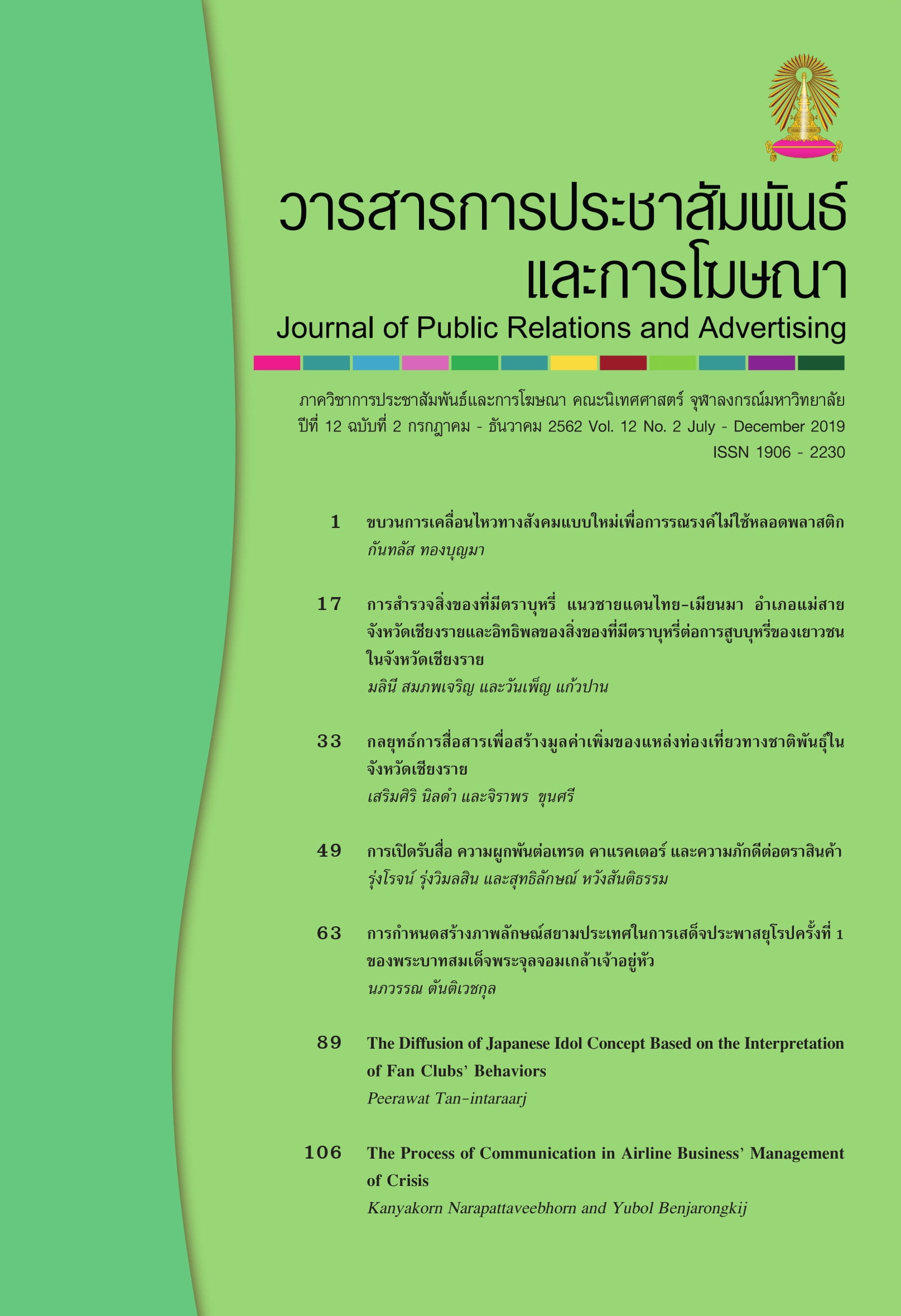Media Exposure, Engagement with Trade Character and Brand Loyalty
Main Article Content
Abstract
The objectives of this study are: 1) to study consumers’ information exposure of trade character, engagement with trade character and brand loyalty, 2) to study the relationship between consumers’ information exposure of trade character and their engagement with trade character, and 3) to study the relationship between consumers’ engagement with trade character and their brand loyalty. Self-administered questionnaires were used to collect data from 400 respondents in Bangkok, aged 18 - 50 years old, including 200 respondents who had eaten at the Bar B Q Plaza within 3 months from the day of the survey and were aware of the trade character, "Bar B Gon" and 200 respondents who had used the services at PTT Oil Stations within 3 months from the day of the survey and were aware of the trade character, "Godji". Results show that: 1) Consumers were exposed to information of trade character at a medium level and demonstrated an engagement with trade character and brand loyalty at a high level. 2) Consumers’ information exposure of trade character showed a significant relationship with their engagement with trade character. 3) Consumers’ engagement with trade character also showed a significant relationship with their brand loyalty. In addition, the affective elements of engagement with trade character had the most influence towards brand loyalty. 4) Consumers’ gender and age differences had significantly different effects on engagement with trade character.
Article Details
References
ชนาภา หนูนาค. (2554). การวัดความผูกพันของลูกค้าในตราสินค้าบริการ. วิทยานิพนธ์ปริญญามหาบัณฑิต สาขาวิชานิเทศศาสตร์ จุฬาลงกรณ์มหาวิทยาลัย.
ภานุ ลิมมานนท์. (2550). กลยุทธ์การบริหารลูกค้าสัมพันธ์ customer relationship management. กรุงเทพมหานคร: ภาริณาส.
รติพร คุ้มทรัพย์. (2545). การวิเคราะห์รูปแบบของ Spokes-character และทัศนคติของผู้บริโภคที่มีต่อ Spokes-character ในภาพยนตร์โฆษณา. สาขาวิชานิเทศศาสตร์ จุฬาลงกรณ์มหาวิทยาลัย.
วิเลิศ ภูริวัชร. (2553, 14 กุมภาพันธ์). Customer engagement ในวาเลนไทน์. กรุงเทพธุรกิจ, หน้า 6.
ศรัณยพงศ์ เที่ยงธรรม. (2553). CRM-CEM รากฐานสำคัญสู่ customer engagement. BrandAge Essential, 4(4), 72-81.
Assael, H. (2004). Consumer behavior: A strategic approach. Boston, MA: Houghton Mifflin.
Callcott, M. F., & Phillips, B. J. (1996). Observations: Elves make good cookies: Creating likable spokes-character advertising. Journal of Advertising Research, 36(5), 73-79.
Chen, H. S., & Hsieh, T. (2011). A study of antecedents of customer repurchase behaviors in chain store supermarkets. Journal of International Management Studies, 6(3), 48-58.
Chiu, Y. K., & Lin, C. Y. (2012). The influence of spokes-characters on consumer patronage intention. Asia Pacific Management Review, 17(4), 421-435.
Drewniany, B. L., & Jewler, A. J. (2013). Creative strategy in advertising (11th ed.).Boston, MA: Wadsworth.
Fisher-Buttinger, C., & Chichester, C. V. (2008). Connective branding: Building brand equity in a demanding world. West Sussex, UK: John Wiley & Sons.
Folse, J. A. G., Netemeyer, R. G., & Burton, S. (2012). Spokescharacters: How the personality traits of sincerity, excitement, and competence help to build equity. Journal of Advertising, 41(1), 17-32.
Griffin, J. (2012). Customer loyalty: How to earn it, how to keep it. New York: The Free Press.
Hollebeek, L. D. (2010, February). Consumer engagement across differentially service-oriented wine outlets: Moving beyond consumer involvement to predict loyalty. Paper presented at the 5th International Academy of Wine Business Research Conference, Auckland, New Zealand.
Hollebeek, L. D. (2009, December). Demystifying customer engagement: Toward the development of a conceptual model. Paper presented at ANZMAC Conference, Monash University, Melbourne, Australia.
Ilicic, J. & Webster, C. M. (2009, November). Exploring dimensions of consumer-human brand attachment. Paper presented at ANZMAC Conference, Melbourne, Australia.
Katz, J. M., Doty, C. A., & Murphy, E. (2009). Case study: The UK’s channel 4 decodes customer engagement: How to measure engagement to drive business results. Cambridge, UK: Forrester Research.
Klapper, J. (1960). The effect of mass communication. Glencoe, IL: Free Press.
Malik, G., & Guptha, A. (2014). Impact of celebrity endorsements and brand mascots on consumer buying behavior. Journal of Global Marketing, 27(2), 128-143.
McCombs, M. E., & Becker, L. B. (1979). Using mass communication theory. Upper Saddle River, NJ: Prince Hall.
Oliver, R. L. (1999). Whence consumer loyalty? Journal of Marketing, 63(4), 33-44.
Phillips, B. J. (1996). Defining trade characters and their role in american popular culture. Journal of Popular Culture, 29(4), 143-158.
Phillips, B. J., & Gyoerick, B. (1999). The cow, the cook, and the quaker: Fifty years of spokes-character advertising. Journalism and mass communication quarterly, 76(4), 713-728.
Solomon, M. R. (2015). Consumer behavior: Buying, having, and being (11th ed., Global ed.). Upper Saddle River, NJ: Prentice Hall.
Tom, G., Clark, R., Elmer, L., Grech, E., Masetti, Jr, J., & Sandhar, H. (1992). The use of created versus celebrity spokespersons in advertisements. Journal of Consumer Research, 9(4), 45-51.
Vivek, S. D., Beatty, S. E., & Morgan, R. M. (2012). Customer engagement: Exploring customer relationships beyond purchase. Journal of Marketing Theory and Practice, 20(2), 122-146.
Wang, G. P. (2002). Attitudinal correlates of brand commitment: An empirical study. Journal of Relationship Marketing, 1(2), 57-75.


